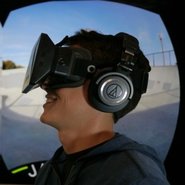By Alex Samuely
The growing number of brands leveraging virtual reality is opening the door to VR commerce, which marketers are tapping to showcase products out of bricks-and-mortar contexts and offer in-store shoppers unique customer experiences.
A slew of retailers – including The North Face and IKEA – have already begun experimenting with VR commerce by showcasing products through mobile applications and complementary headsets that pull into individuals into new dimensions. More brands could implement VR commerce into their revenue-generating strategies in the near future, particularly if they want to help in-store employees upsell inventory or convince consumers to purchase products that had not previously been on their radar.
“Right now, VR commerce is still in its infancy stage, and like most new technologies, is also still in the novelty stage,” said Joe Kleinwaechter, vice president of innovation and design at Worldpay. “The period of curiosity driving people into the store just to try the experience out will then be followed by a period of exploration during which consumers and businesses will try to see what real problems can be solved with the new technology.
“While we’re still in the novelty phase, brands that identify as cutting edge or as directly addressing the early adopters can use this opportunity to dabble with inventory viewers like Gear Commerce or Myers and 3D visualization of completed projects like Lowe’s, or can even allow users to see themselves using products in places other than where they are as The North Face has done,” he said.
“The exploration phase that follows will largely be led by companies that have a strong UX presence and are adept at finding latent consumer needs. These are the ideas that will stick and will ultimately have an opportunity to affect sales in a meaningful way.”
Changing in-store formats
The North Face was one of the earliest purveyors of VR commerce, as evidenced by last year’s implementation of the technology in a South Korean store. In-store employees were tasked with asking customers if they were searching for gear related to a specific season, such as winter sports apparel, before offering them an Oculus Rift headset.
If shoppers were searching for winter apparel, the virtual reality experience took them on an adventure taking place in a snowy locale, accompanied by a pack of huskies.
This type of activation is effective at bolstering customer engagement and serving consumers inspiration for products they may have not been considering prior to walking in-store.
Furniture retailer IKEA has also forayed into virtual reality-inspired shopping with a new mobile experience that enables users to explore various kitchen interior settings and alter them with color preferences (see story). Although shoppers cannot directly purchase the featured products yet, they may become inspired to browse IKEA’s inventory of kitchen items on their mobile devices afterwards.
These initiatives prove that brands are increasingly tapping new mobile-driven ways of boosting sales.
“Gear Commerce’s SOHO VR has created an ecommerce package that developers can use to allow VR shopping of their inventory,” Mr. Kleinwaechter said. “Retale created a tool that allows consumers to enter a virtual showroom of the best deals of the week from a wide variety of companies.
“Other brands, like IKEA’s virtual kitchen, Lowe’s holoroom and The North Face’s virtual tour are all experimenting with VR as a form of customer engagement.”
Mr. Kleinwaechter believes that VR commerce will center on specialty products first before hitting the mainstream market.
Affecting store layouts
Virtual reality commerce also has the potential to disrupt how retailers arrange their store layouts. For example, supermarkets typically place high-margin products at eye-level and put items well-suited to impromptu purchases nearby relevant products.
If the store wants to upsell a particular product that may not be visible at eye-level, leveraging VR commerce to showcase it in a flattering light may be a good solution.
Moreover, allowing consumers to see or experience a product without the constraint of the bricks-and-mortar store could help cinch a sale that would not have otherwise happened. Additionally, brands can leverage the technology to show consumers helpful product tutorials.
The North Face was an early supporter of VR commerce
“Home improvement retailers are uniquely positioned to take advantage of VR by capitalizing on the ‘how to’ concept of fixing things and highlighting the required products to do so,” said Michael Dub, partner at DXagency.
While only a handful of marketers have been early adopters of VR commerce thus far, it is likely that major chains will soon hop on the bandwagon and introduce the technology to shoppers at their flagship stores or other locations with high amounts of foot traffic.
“VR commerce provides marketers with an entirely new experience and marketing channel,” Mr. Dub said. “VR enables the three E’s unlike any other channel (Engagement, Experience, and Entertainment).
“By creating these unique experiences, brands will be able to effectively engage and entertain potential customers in a way that will allow their product to truly come to life and greatly increase the likelihood of conversion. Additionally, VR will afford consumers the ability to transform their shopping experience beyond their local mall or laptop.”
from
http://redirect.viglink.com?u=http%3A%2F%2Fredirect.viglink.com%2F%3Fu%3Dhttps%253A%252F%252Fwww.luxurydaily.com%252Fhow-vr-commerce-could-transform-bricks-and-mortar-retail%252F%26key%3Dddaed8f51db7bb1330a6f6de768a69b8&key=ddaed8f51db7bb1330a6f6de768a69b8

No comments:
Post a Comment